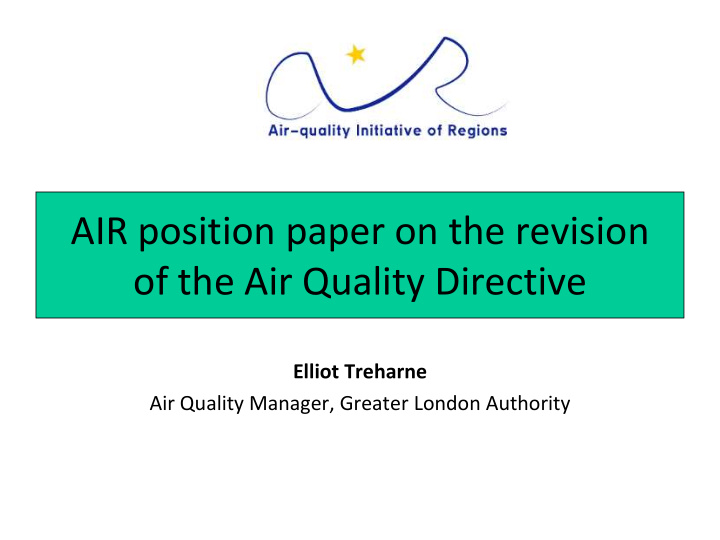



AIR position paper on the revision of the Air Quality Directive Elliot Treharne Air Quality Manager, Greater London Authority
Background • The Air Quality Initiative of Regions (AIR) was founded in 2011 and represents 12 regions from seven European Union (EU) Member States. • These are: Baden-Württemberg, Catalunya, Emilia-Romagna, Greater London, Hessen, Lombardia, North Rhine-Westphalia, Piemonte, Randstad, Steiermark, Veneto and Vlaanderen. • Together these regions represent 22% of EU GDP and 18% of the EU’s population (87.6 million inhabitants). • These regions, which include the most densely populated and industrialised areas of the EU, have been at the forefront of air quality management over recent years. • However, despite these efforts, these regions, like many others in the EU, are struggling to meet some of the limit and target values set in the Air Quality Directive. • AIR welcomes the European Commission’s review of air pollution policy, which was launched on 30 June 2011. • At a conference in Brussels on 10 November 2011 organised by AIR, the group committed to work with all European institutions to contribute a regional perspective to the review of the Air Quality Directive. • The position paper sets out AIR’s priorities for the review.
Overview Protecting human health EU limit values Compliance process Compliance assessment EU-level action EU-wide co-operation
Protecting human health • Given the proven health Protecting human health impacts of poor air quality AIR believes European citizens have EU limit values a right to clean air. • AIR members are committed to Compliance process delivering improvements in air quality in their regions. Compliance assessment • They look to the European Commission to put in place an EU-level action appropriate legal framework which focuses on protecting EU-wide co-operation human health.
EU limit values • Simplification of the limit value Protecting human health regime should ensure action is targeted where there are the EU limit values greatest impacts on human health. Compliance process • The selection of limit values should be determined by the Compliance assessment available health evidence. • AIR also believes simplification EU-level action would aid effective communication of priorities to EU-wide co-operation the public and policy makers.
Compliance process • Where all reasonable and Protecting human health proportionate action has been taken this should be considered EU limit values in the compliance process. • For NO2 this should reflect the Compliance process failure of recent Euro standards to reduce NO x emissions from Compliance assessment road vehicles as expected. • As a consequence there is an EU-level action absence of measures not entailing disproportionate costs EU-wide co-operation to address the large compliance gaps that are now being seen.
Compliance assessment (1) • Compliance assessment of limit Protecting human health values should be based on monitoring supported by modelling, focusing on those EU limit values areas where there is relevant human exposure. Compliance process • Where monitoring data is used this should cover a longer time Compliance assessment period than a single year to reflect meteorological EU-level action fluctuations and other variations. EU-wide co-operation • Transboundary pollution, geographical and meteorological conditions should be considered as well.
Compliance assessment (2) • Where exposure concentration Protecting human health obligations and exposure reduction targets are used EU limit values member states and regions should have flexibility in Compliance process choosing which are the most appropriate areas. Compliance assessment • Modelling standards should be introduced and harmonised EU-level action where possible and emissions databases improved, while maintaining flexibility. EU-wide co-operation
EU-level action (1) • Sectoral emission standards Protecting human health (eg. Euro standards) should be introduced as soon as EU limit values feasibly possible and the timescales linked to limit Compliance process value compliance dates. • Further support should be Compliance assessment offered by the European Commission to incentivise EU-level action their early adoption. • Action at EU level is needed EU-wide co-operation to promote energy efficiency and control all relevant emissions.
EU-level action (2) • There should be greater Protecting human health consistency in European- level environmental policy to EU limit values prevent any contradictory effects on air quality. Compliance process • Air quality should be made a specific priority within EU Compliance assessment funding. EU-level action EU-wide co-operation
EU-wide co-operation • The Commission should help Protecting human health reduce transboundary pollution by bringing Member States and EU limit values regions together. • Through the AIR Group and Compliance process other fora, regions and cities are keen to share their Compliance assessment experiences to maximise the application of best practice at EU-level action regional level across the European Union. EU-wide co-operation • The Commission should identify appropriate ways of supporting and encouraging such activities.
Recommend
More recommend